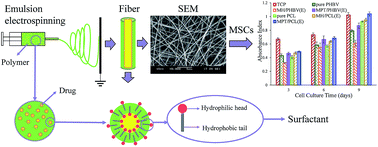Drug-loaded emulsion electrospun nanofibers: characterization, drug release and in vitro biocompatibility
Abstract
Emulsion electrospinning is a flexible and promising technique for encapsulating various drugs into nanofibers. In this work, nanofibrous scaffolds were produced by emulsion electrospinning of either metformin hydrochloride (MH) or metoprolol tartrate (MPT) with poly(ε-caprolactone) (PCL) or poly(3-hydroxybutyric acid-co-3-hydroxyvaleric acid) (PHBV). The influence of preparation processes and emulsion compositions (polymer/drug/surfactant Span 80) towards the drug release behaviour of the scaffolds, together with their morphology, surface and thermal properties were evaluated. In vitro release studies indicated that the emulsion electrospun nanofibers significantly alleviated the burst release and produced a sustained release of drugs compared to the blended electrospun nanofibers. Between the two polymers studied, PCL demonstrated a better drug delivery carrier compared to PHBV, and MPT incorporated nanofibers showed less burst release than the others. The emulsion electrospun nanofibers were evaluated for their cytotoxicity using human mesenchymal stem cells and the cytotoxicity results showed that the emulsion electrospun MPT/PCL scaffold favoured cell growth compared to other tested scaffolds. Our study shows that emulsion electrospinning could be a better technique than normal blend electrospinning, especially in modulating the drug release properties by regulating the oil phase and water phase of the emulsions to obtain the desired drug release for the drug delivery systems. And PCL may be a better drug delivery carrier than PHBV.


 Please wait while we load your content...
Please wait while we load your content...